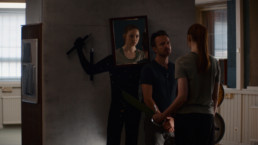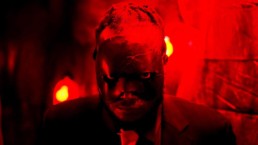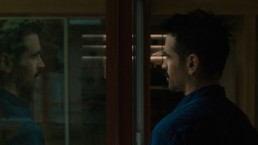'The Unbearable Weight of Massive Talent': The Passion of The Cage
Where to watch: 'The Unbearable Weight of Massive Talent' is now playing in theaters nationwide.
Nicolas Cage, Hollywood's mightiest cheese, stands alone. His specific style of comically exaggerated showmanship is renowned, praised, and singular unto himself. His larger-than-life, over-the-top performances channel Brando, using his intense instincts and manic energy to not just bring his characters, but every movie he's in, to life.
And while over-delivery might plague the career of any other person, Cage's performances never feel false. The beauty, purity, and dare I say genius of Nicolas Cage is that his highly theatrical acting feels like it comes not from a place of caricature but of real passion. It comes from the connection he makes to what's on the script's pages.
In the second half of his career, Nicolas Cage and his manic style have also been re-appreciated in this post-modern internet age, where audiences' connection to pop culture now also comes with an implicitly ironic consumption. Which makes his starring role–as himself–in the very meta movie The Unbearable Weight of Massive Talent a move to complete this Cage-issance.
https://www.youtube.com/watch?v=CKTRbKch2K4
In The Unbearable Weight of Massive Talent, Nicolas Cage stars as "Nick Cage"–a Hollywood actor who's scrambling to land his next big hit. Although he's a movie star, he's also not above giving impromptu auditions to directors in line at the valet of the Chateau Marmont. Here, he's equal parts passionate student of the craft, as well as obnoxiously ego-centric A-lister.
This "Nick Cage" is a star that's driven by his love of show biz and his own star power, but with insecurities as well. But he's got his ego in his corner to pop up and give him pep talks: a leather jacket-wearing bad boy-era version of Cage named "Nicky" (fun fact: Cage is double-credited in the film for "Nicky" as Nicolas Kim Coppola, his real birth name). Nicky constantly fuels Nick's ego that the next hit film will bring him (them) back; while re-assuring him, "Not that we ever left."
Cage's drive for his career has made him succeed but it's driven his family away. His ex-wife (Sharon Horgan) and daughter (Lily Mo Sheen) are clearly past the point of tolerating Cage's self-interest, leaving Cage more alone on most fronts. He thinks landing the next big film will bring his family together, while his family thinks that would only keep them apart.
And so, a now-desperate (and cash-strapped) Cage takes the next gig that lands from his agent (Neil Patrick Harris): a birthday appearance for a wealthy superfan Javi (Pedro Pascal). A reluctant Cage agrees but not before he's intercepted by CIA agents Vivan (Tiffany Hadish) and Martin (Ike Barinholtz) who inform him that Javi's also a Spanish crime lord who kidnapped a rival's family member.
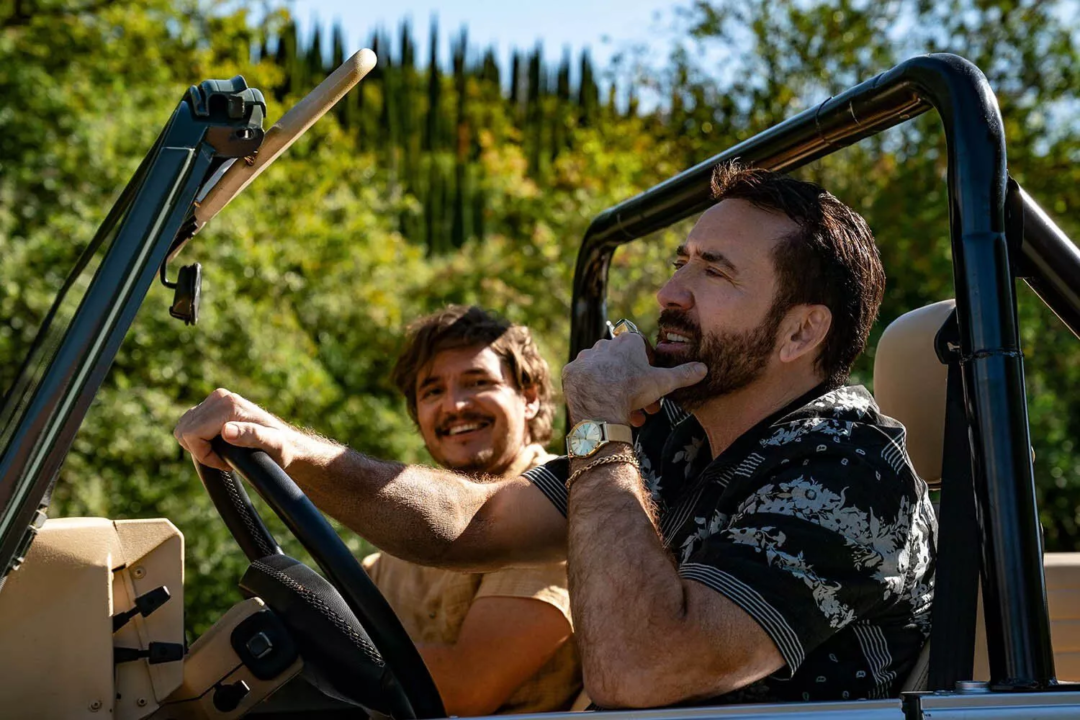
It's a fun twist that gives Cage a role to play: undercover spy. But Javi is so earnest and kind to Cage that a bromance ensues (he agrees to read a script that Javi wrote). The story deepens as Cage gets closer to Javi, conflicted about his new friend who he's agreed to trap–if Javi really is the crime lord that the CIA thinks they're after.
Directed by Tom Gormican (That Awkward Moment), The Unbearable Weight of Massive Talent is a crowd-pleasing comedy that I very much enjoyed watching on the big screen with a packed audience. Gormican's script (which he co-wrote with Kevin Etten) succeeds as both an entertaining action-comedy as well as a Hollywood satire where broad comedy and inside jokes that call back to Cage's career are fun throughout.
As the top-billed stars and central relationship here, Cage and Pascal are wonderful together. Their chemistry is right, with Pascal playing sensitive super-fan to Cage in just the right ways. Perhaps the funniest scene of the movie, in which Nick agrees to take LSD as inspiration for them to write a movie script together, is just hilarious fun. Their comic pairing delights throughout, keeping you on edge for what happens at the end of the film.
The Unbearable Weight of Massive Talent is a fun time at the movies that will make you remember the greatness of Cage.
1h 47m. Distributed by Lionsgate. Rated R for language throughout, some sexual references, drug use, and violence.
'The Northman' Owns the Big Screen With Its Astounding Viking Vision
Where to watch: 'The Northman' is now playing in theaters nationwide.
What do we expect from movies today? That they merely entertain us (and be preferably under-90 minutes)? I think of Russell Crowe's rhetorical shout from 2000's Gladiator: "Are you not entertained?," how it's directed not just at those watching from the arena but to the film's audience themselves. When a film is so extravagantly imagined and so magnificently constructed that its ambitious artistry is so obvious onscreen, is that not enough to be entertained? I imagine writer-director Robert Eggers will ponder asking audiences this sentiment with his brutal and brilliantly ambitious new film, The Northman.
The Northman (now playing in theaters nationwide) attempts to be something that lives in the shallow end of being merely "entertaining." Or perhaps more honestly, it attempts to be entertaining by way of blowing movie-goers' goddamn minds away with its period-faithful, painstakingly created images and sequences of Viking past. We're supposed to feel every bit of muck and mud that this Northern Man trudges through, along with feeling every broken bone and torn tendon (whether his own or others) in his single-minded quest of avenging his slain father. It's all so visceral and felt that we can't help but be stunned into helpless submission on this journey into the depths of darkness.
With three feature films now under his belt, we can safely identify the joy–or drive (or obsession)–that Eggers follows when making his films. That being, re-creating worlds of a primal and dangerous past to subject his audiences to. He's a filmmaker who hears this siren's singular call, pulling him (and us along with him) back into time to revisit and unearth some ancient enchantments and spirits that have laid dormant. Simultaneously, Eggers is a man clearly possessed with the need to honor the most period-accurate production choices (which was captured in this fascinating Eggers profile by The New Yorker). It's as if he were the appointed chaperone on a disturbing and perverse time-traveling field trip.
Related: Review: 'The Witch'
https://www.youtube.com/watch?v=oMSdFM12hOw
While 2015's The Witch and 2019's The Lighthouse were trips that ended in madness, either losing your mind or yer beans, The Northman is actually the most straightforward of Eggers' three "The" films. It's the story of Amleth (Alexander Skarsgård), who, as a child (Oscar Novak), swears to avenge his father, King Aurvandil War-Raven (Ethan Hawke), after he's murdered by his uncle Fjönir (Claes Bang). If that story sounds familiar, it's because it's the story that inspired Shakespeare's Hamlet (which inspired Disney's The Lion King). What we get here for its 2h 16m runtime is the unwavering journey that Amleth takes in infiltrating and strategically advancing himself to be able to make his inevitable challenge to his uncle.
Related: ‘The Lighthouse’: Take This Drunken Plunge Into Madness
Unfortunately, it's here where The Northman falls on its own sword. For being so visually astounding and ambitious, the story stays, dare I say, faithful to its simplest form. Knowing we're waiting for this avenging son to make do on his self-made promise, we're kind of left waiting to see what moments of consequence are stuffed here until then. Amleth meets Olga of the Birch Forest (Anya-Taylor Joy) and a partnership and romance ensue. But unfortunetely, we're kept away from any inner-character scenes by the brooding mad, bear-like Amleth (Eggers and co-screenwriter Sjón kept it from going there). There is a bit of a surprising twist that comes late in the film (which I won't ruin) but even that didn't disrupt what is ultimately a pretty predictable story that dulls the impact of the final death blow.
Yet, while The Northman stays painstakingly committed to reaching that ambitious north star, I'm still on the side of advocating for and celebrating this film. While it won't be as beloved as The Witch or The Lighthouse, it's still a dazzling, commanding film that inspires awe for what movies can be. Yes: I am entertained.
2h 16m. 'The Northman' is rated R for strong bloody violence, some sexual content, and nudity.
'Dual': Karen Gillan Must Duel Her Clone In This Dark Comedy
In writer-director Riley Stearns' latest feature film, Dual, a woman and her new clone are forced to battle to the death in order to win the right to continue living that person's life. With an array of medieval weaponry provided to them in order to defeat the other, Stearns sets the stage for a gruesome gladiator-type match-off of "Hunger Games" proportions.
However, fans of Stearns and his previous films will know that he's not interested in grisly bloodsport. Rather, he uses it as a backdrop to show the comic absurdity of people, and the lengths we'll go to in asserting agency over our lives.
In Dual, Stearns furthers his signature directorial style, filtering dark, depressing stories through an ultra-serious lens. The result is an enjoyably, strangely hilarious time that's also entertaining and always thought-provoking.
Related: 'Faults,' a Dark Comedy About the World of Cults
Making its world premiere at this year's Sundance Film Festival, Dual stars Karen Gillan as Sarah, an apathetic woman who moves through her unjoyous life by chowing down on fast food and ignoring her mom's calls. Her sad existence is immediately upended after she's diagnosed with a life-ending disease. The doctor says "You're going to die," to which Sarah replies, in deadpan delivery, "Why aren't I crying?"
Gillan's delivery–along with that of everyone else's in Stearns' detached, cold, emotionless world–ends up making every grim line that's uttered something to grin at. The over-seriousness only highlights the movie's total silliness, which then sets up the main part of the story: Sarah is offered the opportunity of getting a "Replacement"–a clone of a terminally ill patient–to leave behind as a gift for a grieving family.
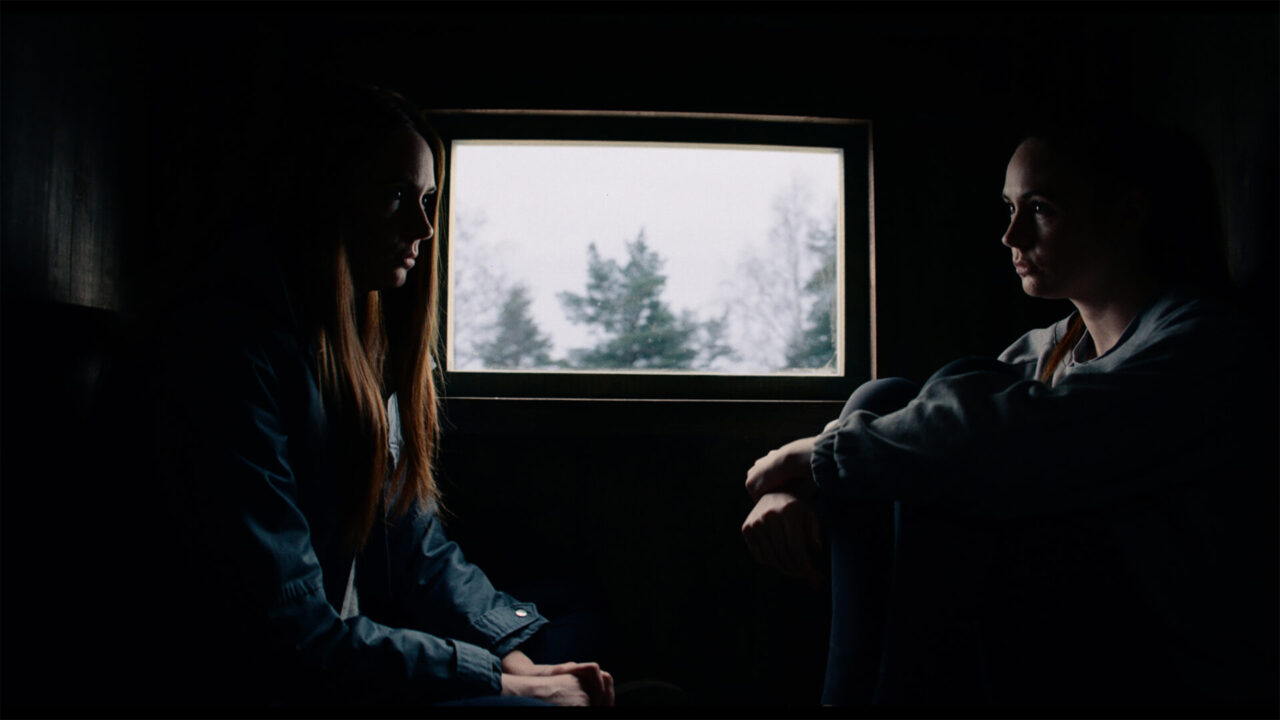
Without giving it too much thought, Sarah agrees, and "Sarah's double" arrives shortly. Standing shoulder-to-shoulder, Sarah's double begins soaking up everything about Sarah before she eventually takes over when Sarah she dies.
Except that, in a turn of events, Sarah learns that she's not going to die. Instead, she goes into full remission. Furthering the universe's idea of a sick joke, Sarah's double has now lived long enough to develop her own self-awareness and has totally taken over Sarah's (the original's) life, including dating her old boyfriend (Beulah Koale) and developing a healthy relationship with her own mom (Maija Paunio). Sarah, then, is edged out of her own life.
The scenes of Karen Gillan acting opposite herself are deceivingly well exacted. Not only is the technical staging impressive, but Gillan even stated that she learned both characters' lines at the same time, recording one version so that she could run lines with herself.
Under the rare circumstances in which an original and double continue to live, they are forced to enter a broadcasted deathmatch (yes, a duel of the "duals") to see who can continue living on (because a world in which two clones would be left living would be simply ridiculous). Now inspired to take back her life, Sarah hires a combat trainer, Trent (Aaron Paul) to teach her the ways of fighting so she can defeat her double.
https://www.youtube.com/watch?v=tvChEgWlqbQ
The idea of a weak person deciding to assert themselves through fighting is another idea that's carried over from Stearns' last film, The Art of Self-Defense (which starred Jesse Eisenberg as a white-collar wimp who re-asserted his life through martial arts). It's great to see Stearns continue sharing his personal passion for jiu-jitsu with audiences, which makes his films even more personal and unique.
Related: ‘The Art of Self-Defense’ Kicks Ass – Pun Intended
With a sageness in the art of combat that Dwight Schrute would likely appreciate, Trent trains Sarah in various forms of combat, teaching her moves, the best way to use weaponry in different situations, and identifying various methods of death. In these scenes, Gillan and Paul are fantastically paired, and certain scenes are sure to stick in audiences' minds long after (slow-motion fighting, and hip hop dance classes among them).
I won't spoil the ending, but by the time the film circles towards its climactic end, you realize that aside from its somewhat sadistically silly conceit, there's a deeper, more tender-hearted idea that Stearns is ruminating on: what would you do to fight for your life? Would you be prepared to become someone entirely new, and in that regard, kill the old version of yourself? Dual is a thought-provoking, clever, and fun way to explore the idea of what we're all willing to do to re-assert ourselves and our lives.
95 min.
The review originally ran on January 24, 2022, during the Sundance Film Festival.
'7 Days' is a Cute Romantic Comedy for the COVID Era
Our review of ‘7 Days’ was first published as part of our Tribeca Film Festival 2021 coverage.
Where to watch: Now playing in select theaters. In Los Angeles at the AMC & Alamo Drafthouse Downtown.
Making its world premiere at the Tribeca Film Festival 2021, 7 Days is a feel-good, charming and heartfelt rom-com that perfectly captures this modern moment. It's a pretty conventional rom-com set-up that we've seen before: two young people go on an awkward first date, and when forces greater than them trap them together, must endure each other for much longer than anticipated.
But 7 Days adds to that simple setup. The film's writers–director Roshan Sethi, and one half of the film's stars' Karan Soni–give 7 Days its unique voice by crafting the central premise around experiences they both know well: the pressure felt by young Indian-Americans from their traditional parents to find their future spouses.
We soon find that Ravi (Karan Soni) and Rita (Geraldine Viswanathan), pleasant as they are in person, don't exactly attract. The comedy comes quickly once they find themselves trapped together by COVID's shelter in place orders (the film was shot during the pandemic as well), and it's here where we find that there are some discrepancies in who their parents promoted them to be on their date.
Rita (Geraldine Viswanathan) turns out to be less than traditionally conforming, cracking a morning beer and stowing away to talk to her "daddy" while carelessly leaving her vibrator lying around the house. This shocks the straight-laced and more traditionally-minded Ravi (Karan Soni), on track for medical school and startled to see Rita's true colors.
Between the laughably awkward moments and reveals that Ravi and Rita experience together, 7 Days makes for a very funny time. Geraldine Vaswanathan adds her effortless appeal here, but it's Karan Soni who, as the hilariously effeminate and uptight Ravi, earns most of the laughs, each new reveal eeking out a quietly terrified reaction.
Past the cute setup, 7 Days takes on the more grim reality of COVID (impressively, director Roshan Sethi is also a doctor), and we are given a deeper emotional story than before. It's here when real life health concerns force Ravi and Rita to acknowledge the larger parts about their lives, with their anxieties about getting older and the pressure of finding their future spouses.
Although it all takes place in a single room, the film presents a much bigger scope of life and explore's how the world's bigger than ourselves. The single location does present a limited vision then what you might be familiar with, but it's also what allows the actors to be so comfortable. And it's so well-paced that it doesn't feel limited, exploring little moments like cooking food together and getting drunk in fun ways.
There's definitely not as much cinematic bravado as say, Netflix's Malcom & Marie, a much more self-serious and technically deliberate look at dating and exploring space within a single location. But here, watching Ravi and Rita is like hanging out with fun and affable friends, and the relaxed writing and performances all adds to the film's simple charms.
To these ends, 7 Days is impactful because of its accurate look at young people's mindsets, of which looking for love, completion and the future are all so present. It's also impactful because they track COVID's deadly progression along with the meet-cute story, which is a strange layer of reality to see so soon following the very real pandemic.
And yet, 7 Days remains a fun, easy-to-watch romantic comedy that's straight up funny, going for every laugh it goes for, before becoming a sincere and heartfelt story on relationships in the age of a pandemic. It also leaves you wondering, how am I going to live after COVID? Who will I choose to be, and who will I choose to love? Will I choose to play things more traditional and safe, or dare for something more in this new world full of possibilities?
86 min.
SXSW: 'Bitch Ass': A Slasher Horror From the Hood
With its forwardly foul-mouthed title alone, Bitch Ass certainly makes a stark first impression. That same confrontational quality carries through in writer-director Bill Posley's self-assured film. Certainly, it exudes bold, confident energy from beginning to end. Ultimately though, Bitch Ass's templated writing, low production value, and lack of distinct directorial vision limit it to only being a low-entertainment slasher film.
It's not for a lack of having ambitious inspirations that Bitch Ass doesn't succeed. Opening with a Vincent Price-like narrator who quite literally references famous Black slasher films like Bones, The Bone Collector, and People Under the Stairs, we can assume that director Bill Posley (who also wrote the film with Jonathan Colomb) reveres the genre he's working in. But as Bitch Ass continues, it's pretty clear that those references are more aspirational than earned.
The story follows a group of high schoolers who, at the instruction of gang leader Spade ( ) on "666 night" (just a scary-sounding name), break into the house of a deceased woman to rob it. Little do they know, the youths have stumbled into the house of "Bitch Ass," a once-bullied high schooler who has transformed from a victim–with a love of board games–into a sadistic serial killer, who challenges his prey to elaborately-staged games to the death.
It's not hard to imagine how Jigsaw's infamous "Do you want to play a game?" line may have provided the entire grounds for this story. As the kids enter the house and subsequently get picked off (is everyone really unable to hear each other's blood-curling screams from within this suburban two-story house in the middle of the night?), they each become victims for these games, that wink at names like "Operation" and "Battleship" by re-naming their grizzly counterparts as "Surgeon" and "Mayday."
Bitch Ass is at its most unique and entertaining when we are in the moments of these games. The film quite literally goes into a "versus mode," entering different styles of split screens in which to capture the screaming faces and scenes. But these moments are also pretty cringingly staged, which only exposes the film's silliness rather than scariness. At its best, it's a fun campy experience but at its worst, it's like walking through a cheap haunted house.
If I could ask director Bill Posley a question, it'd be why he never changes the lens on any shot within any scene. Every shot is noticeably ultra-wide, which makes for an odd watch and also compresses the film into one emotional note, making it feel flat and poorly designed. The film could have been heightened even more if we saw varied shots so as to get different experiences within the characters and storytelling.
Even though Bill Posley's execution might not be all the way there, he does offer a lot in terms of creativity and ideas. He aspires to weave together a slasher story while also flashing back to making an origin story of the high schooler who was bullied. He is routinely called "Bitch Ass" by the bullies who torment him, to which the film gets its exciting name; but I think a title that's more board game-related (Don't Pass Go?) would better characterize this movie.
If you're looking to watch a campy slasher movie, or if you're curious to see a version of Saw that is quite literally based on kid's board games, you may enjoy the cheap thrills that Bitch Ass offers. While I didn't find that it transcended its low-budget limitations to become anything more, there's a level of inventive storytelling and raw power that makes Bitch Ass a defiantly unique movie.
'Alice' is Part-Slavery Film, Part-Blaxploitation Riff
Our review of ‘Alice’ was first published as part of our Sundance Film Festival 2022 coverage.
Where to watch: Now playing in theaters.
Alice opens with a shot of a woman running desperately through a field. More specifically, she's a Black woman in a plantation dress, so we have an idea as to why she's likely in fear. She runs until she stops. And then, she lets out a blood-curdling scream. A curiously anachronistic title card covers the screen: "Alice," in a very 70s style font.
This intro and title card reveal is stylistically cool, but also a bit clunky. So is most of first-time feature filmmaker Krystin Ver Linden's directorial debut, Alice, in which a runaway slave escapes her plantation, only to find herself in a different reality.
It's a hell of a premise (actually, I learned that it's also very similar to the 2020 horror film Antebellum, which I've yet to see). Alice is one of those films with a really interesting concept but not a great execution. For this reason, I think some people will really dig it for its inventive and fresh storytelling but if you're like me, you won't be able to escape the problems with its awkwardly mashed-up tone and narrative incomprehension.
https://www.youtube.com/watch?v=ZwbhXcwWoM4&feature=emb_title
Back to that opening: it's actually a very exciting start, and really pretty gripping. When that groovy title card splashes across the screen, you think it's immediately about to swerve into fun. But it doesn't. Alice then slogs through a multitude of scenes of plantation life, which move painfully and slowly forward. Any sense of urgency is lost, and we even lose Alice (Keke Palmer) for a good while, too.
Although it's pretty beautifully shot, with very fine period piece production (including its location, costume, and cinematography), the story doesn't launch us forward in an exciting way. For one, we get way too much screentime from Jonny Lee Miller as Paul Bennet, the plantation owner. There are exciting early moments like a different (unsuccessful) runaway attempt. But it's so awkwardly choreographed and without Alice being involved herself, it's confusing to wonder where this movie is really headed.
It's almost halfway into the film when Alice finally asserts herself (running away from that intro's plantation) and the movie makes its reveal. It's not exactly a spoiler to give away what happens next (think M. Night Shyamalan's The Village). In fact, I think people's interest in this movie will be roused by knowing that once Alice runs away and gets to the side of the road, she's almost hit by a car zooming down the highway. It's not the Antebellum south, but somehow, 1973.

She's picked up by truck-driving Frank (Common), who gives her a ride into town. He apparently doesn't find it odd that not only is she struggling to comprehend everything around her in wide-eyed panic, but she's also covered in blood (there's a struggle she's involved with before she gets here). Frank takes Alice to the hospital, but when he sees that she might be admitted to the psychiatric ward, he decides to let her stay with him to look after her.
You might be able to guess what happens next: Alice slowly comes to grips with what time of year it is, a time in which slavery has been abolished (although, she is smack dab in the Civil Rights act). Again: an interesting idea, but the writing doesn't totally work here. Rather than panicking that she's somehow transported a century into the future (or has she?), she's left with lines like asking Frank, "Are you free?," and to his fellow farmworkers, "Are these your domestics?" Keke Palmer gives everything she has to this performance but the awkward writing and story choices force her to do some pretty eye-rolling acting.
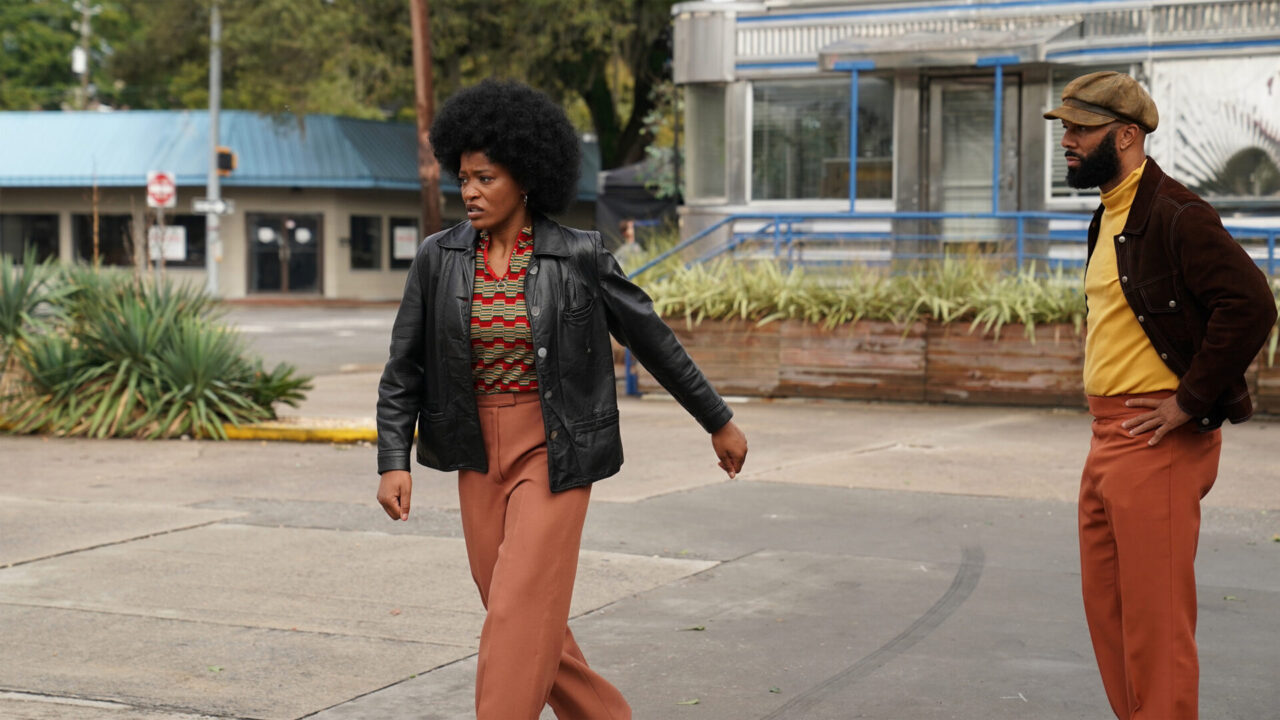
Now able to read books in Frank's apartment, she phonetically sounds out words like "slavery" and "Emancipation Proclamation"–which would have been more powerful if silently conveyed. It's this sort of deliberateness throughout Alice that makes the film a little too heavy-handed.
If you're able to get past the awkward writing, then you'll likely appreciate all of the fun that is to (eventually) come. Alice's education and consumption of Black culture are captured through different pop culture media: in magazines like Ebony and Rolling Stone, Stevie Wonder and Nina Simone, and on TV like Sanford & Son and Black Panther news. And then, all roads lead to Alice's most transformative moment: going to the movies to see Pam Grier's iconic classic "Coffy," the singular moment that then shifts the movie from slavery film, to time travel movie, to wild Blaxploitation ending (think Django Unchained meets Back to the Future).
While there are some problems with the story, it's undeniable that Alice is still a fresh new story and interesting vision from a first-time filmmaker, whose idea and concepts should be celebrated.
100 min.
'After Yang' is a Gorgeous, Thoughtfully Imagined Sci-Fi Meditation
Our review of 'After Yang' was first published as part of our Sundance Film Festival 2022 coverage.
Where to watch: Now playing in select theaters and on Showtime.
With his gifted eye for aesthetics, Kogonada's films are among the most arresting in movies today. His ability to compose beautifully designed, richly crafted shots of environments and the people who inhabit them, makes his films visually and singularly special. Add to that, his inclination as a storyteller to explore deeply meditative stories that reflect on the meaning of life, and you'll find that watching a film by Kogonada is a truly transcendent experience. What's crazy about that high praise is that he's only made two feature films to date: 2017's Columbus, and now, After Yang.
It might give you pause to wonder how a person who's only made two movies in his life could make them so artistically accomplished. However, those who know Kogonada's story also know that, prior to directing, his professional career consisted of creating video essays, whose excellence elevated the importance and recognition of the entire medium as an art form itself.
Understanding and showcasing the filmmaking methods of cinema's greats is no doubt what also made his first feature, Columbus, so refined and such a praiseworthy debut. Here, with his even more ambitious second feature After Yang, it's exciting to see him expand his artistic talents by entering a world of highly conceptual sci-fi that visualizes even more complex worlds with even deeper questions to ponder.
Making its world premiere at last year's Cannes Film Festival, but now making its North American premiere at this year's Sundance Film Festival, After Yang is set in the future in which humans exist alongside artificially intelligent androids, whose self-aware sentience now force humans to confront their own lives; and with that, their shortcomings.
Adapted from a short story by Alexander Weinstein ("Saying Goodbye to Yang"), After Yang tells the story of a beautiful–but at first glance, curiously diverse–family, whose connection we've yet to understand. We learn that Jake (Colin Farrell) and Kyra (Jodie Turner-Smith) are parents to an adopted Chinese daughter, Mika (Malea Emma Tjandrawidjaja). The last one to run into the framing of a self-timed family photo is the techno-sapien, Yang (Justin H. Min).
Yang's inclusion in the family is part of society's larger trend in which parents buy "Second Siblings," autonomous robots that are able to provide companionship as well as a cultural history of their adopted children's heritage to them. Wise and thoughtful, Yang also provides philosophical guidance to Mika, helping her better understand her own adoption, in one instance likening her to a branch that's been grafted onto a tree to create new life. In this respect, Mika's connection with Yang is uniquely special. So, when Yang abruptly stops functioning, it throws Mika into disarray. Jake takes Yang to a third-party worker, and when Yang is examined, a discovery leads to shock: a piece of technology is found to allow Yang to create memories from his life.
Kogonada uses Jake's studying of Yang's memories (visualized as gorgeously glowing web-like stars in the sky) to reflect upon how much he's lost touch with his own family, and the special moments he's overlooked in his own life. Montages of these fleeting moments from Yang's point of view–daylight spilling in through a window, leaves nestling in the wind, nature in its most simple and beautiful form–are beautifully lensed by cinematographer Benjamin Loeb (When You Finish Saving the World). Similar to Pixar's Soul, the mundane moments are seen as the real magical moments of life.
It's here, within the reviewing of these temporal, fragile memories that Kogonada puts forward his deepest questions and philosophical statements. I can't stop thinking about one such scene between Yang and Kyra, in which, as they discuss the temporality of life, Yang wisely quotes Lao Tsu, saying "what the caterpillar calls the end, the rest of the world calls a butterfly."
A moving score from ASKA, as well as an additional theme composed expressly for the film by Oscar-winning legend Ryuichi Sakamoto, add even more beauty to After Yang. Kogonada's masterfully crafted second feature film examines life's deepest questions on the grandest level of life. What's more, we also see Kogonada reflect on his own Asian ancestry, which also allows the audience to question our own identities through understanding our ancestry.
The performances throughout the film are all emotionally felt. Each of the actors' scenes, including Colin Farrell, Jodie Turner-Smith, Justin H. Min, and Haley Lu Richardson, all resonate deeply in their tender honesty. They convey a tranquil serenity to Kogonada's gorgeously created world, while also expressing such deeply felt feelings like grief, loss, and the fear of life's finiteness.
While you'll have to slow yourself down to its patient, slow-burning pace, it left my heart swelling, eyes tearing, and soul transcending. After Yang is a deeply beautiful, profound, and amazing achievement from Kogonada that will make you look at your world and life with a little more wonder after.
96 minutes.
The Sweeping Musical 'Cyrano' Aims For The Heart, and Hits
The new movie Cyrano is a heartfelt romantic musical that turned me into putty in its hands. Based on the timeless tale of Cyrano de Bergerac–a man gifted with words yet fated with an unconventional appearance–it's the story of a heartbreaking and tragic love triangle. However, seeing the power of true love on screen also makes for one of the most uplifting movies to see this season.
When he learns that his friend and secret love, Roxanne, has fallen in love with another man, the gifted wordsmith Cyrano agrees to write his love letters to her. Concealing his own feelings, he resigns to living a life where he hides away his love. Directed by Joe Wright (Atonement, Pride & Prejudice), Cyrano stars Peter Dinklage in the title role.
From Stage to Screen
The original story goes back to the classic “Cyrano de Bergerac,” written by Edmond Rostand. Director Joe Wright's Cyrano is based on the most recent stage play adapted and directed by Erica Schmidt (who's married to Dinklage). Previous versions of the story make Cyrano's comically long nose his character's tragic physical feature. Yet the film uses Peter Dinklage's short stature as the attribute that fuels Cyrano's insecurities and society's rebuke.

For such an open-hearted romantic musical to work, the music needs to be truly moving. And this score is. Written by The National (music written by Aaron & Bryce Dessner and lyrics by Matt Berninger & Carin Besser), Cyrano's soundtrack is brooding and moving in ways that fans of the band will recognize. The most sweeping song that is sure to stick with audiences is "Someone to Say." It's a heartwrenching and beautiful song that's buried itself deep in my head since seeing it in the film's trailer.
Peter Dinklage Captivates
As the title character, Peter Dinklage captivates and commands the screen. He showcases his trademark charm and wit. But seeing him long for Roxanne as a sort of doomed "Phantom of the Opera" shows even more range than what we've seen from him before. His chemistry with Roxanne–the centerpiece romance of the film–is also uplifting and heart-aching. As Roxanne, Haley Bennett is wonderful. Her singing voice is beautiful, her character desirable, and her character so pure-hearted.
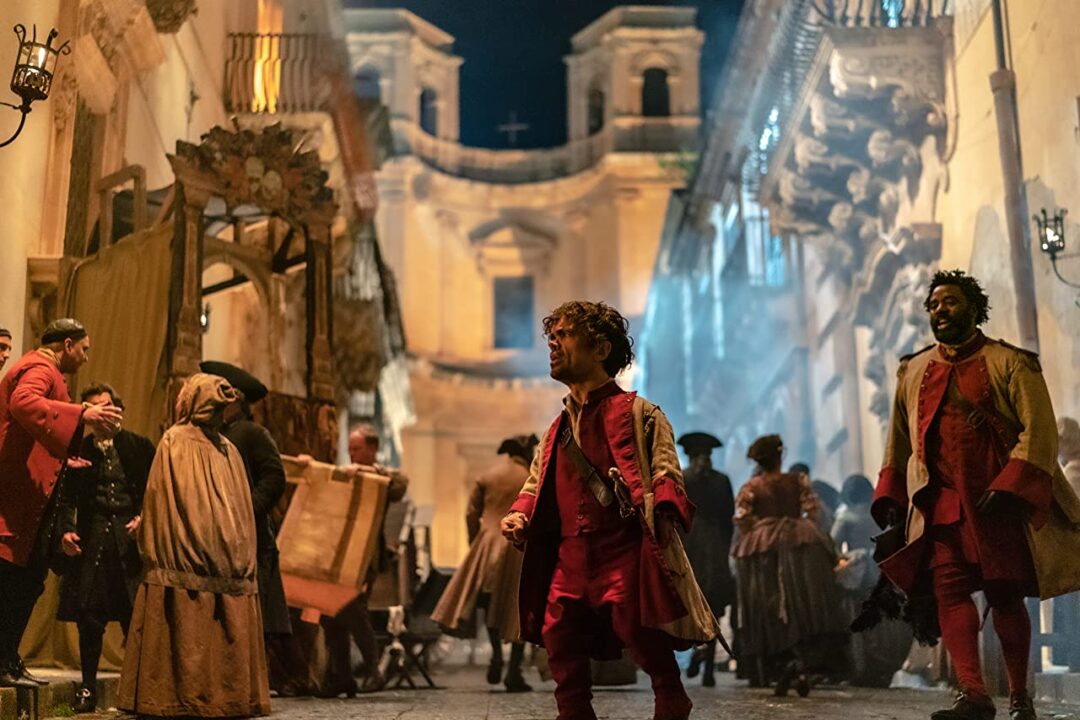
Rounding out the cast is Kelvin Harrison Jr. as the young Christian. As the one who Roxanne falls in love with, at first sight, his role is tricky. Christian needs to play the "dumb hunk" who needs Cyrano's words, but also someone with who we connect to and sympathize with. And Harrison Jr. plays both sides well, with a great singing voice too. The real villain role is saved for Ben Mendelsohn. As the powerful De Guiche, Mendelsohn snarls his way into banishing both Cyrano and Christian away from Roxanne–who De Guiche himself is set to marry–by sending them into a war that looms large over the country.
A Heartaching Love Story
If there's anyone who knows how to make an impassioned romantic period piece film, it's Joe Wright. His most recent sweeping love stories Pride & Prejudice (2005) and Atonement (2007) are among the more recent classic love stories in modern cinema. Although Cyrano is his first musical, Wright knows how to craft a heart-aching love story and make it resonate with audiences. With exceptional performances from Dinklage and Bennett, as well as The National's moving score, Cyrano moved me in all the right ways.

Ultimately, I absolutely recommend Cyrano to fans of musicals, period piece films, or fans of sweeping romantic dramas. Fans of Joe Wright, Peter Dinklage, or The National will also find plenty to love about Cyrano. It's an accomplished film and respectable musical. And it is sure to resonate in your head and heart long after watching.
2h 4m. 'Cyrano' is rated PG-13 for some strong violence, thematic and suggestive material, and brief language. In theaters on February 25, 2022.
This review originally ran on December 28, 2021.
https://www.youtube.com/watch?v=5e8apSFDXsQ&ab_channel=MGM



